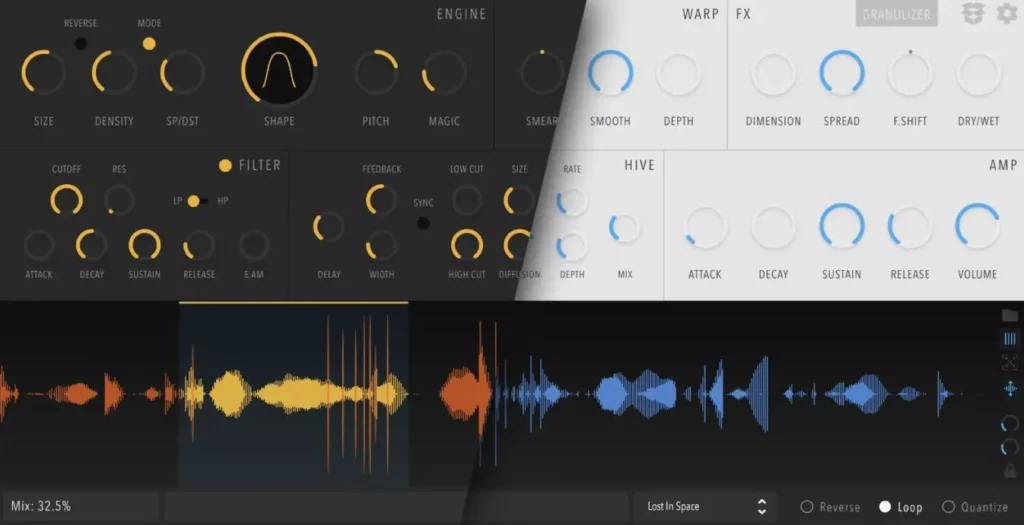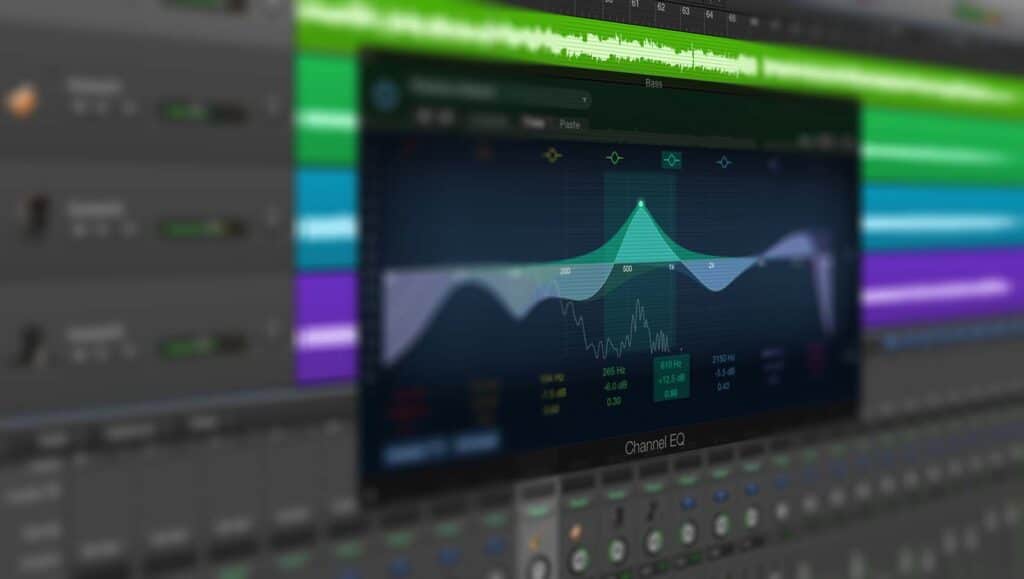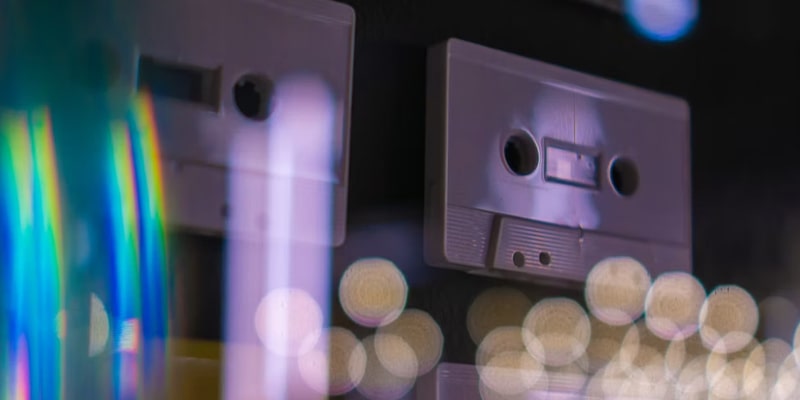Granular synthesis is a unique sound synthesis method that operates on the microsound timescale. Unlike traditional methods such as subtractive, additive, or FM synthesis, granular synthesis uses audio samples as its fundamental material.
What is Granular Synthesis?
This method is based on the same principle as sampling. However, the source audio material is split into very short fragments, known as grains. The duration of these grains typically ranges from 1 to 100 milliseconds (ms).
Granular synthesis involves manipulating, rearranging, and playing back these grains, often in large quantities, to create new musical textures. Multiple grains can be layered on top of each other, and they may play at varying speeds, phases, volume, and frequency, among other parameters. Since the synthesis depends on the source audio, you can create countless unique timbres, limited only by the source material.
Granular synthesis offers immense creative potential, allowing for the creation of sounds unachievable by other methods. The results often tend toward creating nebulous, cloudy, smeared, frozen, fragmented, or glitchy versions of the source material. However, the effect can also be intensely rhythmic, pulsing, and percussive. Granular synthesis is widely used in electronic, dance, experimental, alt rock, and cinematic music, as well as genres like Glitch Hop, Neurofunk, and IDM.
Historical Milestones
The concept of granular synthesis originated with the physicist Dennis Gabor, who, in 1947, introduced the idea that sounds could be represented as a series of elementary “grains,” each being a short pulse containing both temporal and frequency information.
Greek composer Iannis Xenakis is known as the inventor of the granular synthesis technique, having expanded upon Gabor’s theoretical foundation. In 1960, Xenakis explicated a compositional theory for grains of sound. He created granular sounds using analog tone generators and tape splicing. These sounds appeared in his composition Analogique A-B (1959) for string orchestra and tape.
Curtis Roads was the first to implement granular synthesis on a computer in 1974.
A significant breakthrough occurred twelve years later, in 1986, when Canadian composer Barry Truax implemented the first ever real-time version of this synthesis technique. He utilized the custom-built DMX-1000 Signal Processing Computer. Truax’s work Riverrun (1986) is acknowledged as the first real-time generated granular work. Truax was also the first composer to explore the range between synchronic and asynchronic granular synthesis in Riverrun (1986). Furthermore, he was the first to use a sample as the source of a granular composition in Wings of Nike (1987).
Key Parameters of Granular Synthesis
Despite considerable variation in the interfaces and terminology used in granular synthesizers, they are often underpinned by identical concepts. The main control elements include:
- Grain Size / Length: Defines the duration of an individual grain.
- Short grains at low density create discontinuous, glitchy spikes of sound.
- Longer grains at high density result in a smooth, blurred, and smeared sound, ideal for creating rich atmospheric textures and pads.
- Density / Rate: Determines the frequency or speed at which grains are generated. Some developers use an “Overlap” parameter instead. High density causes dozens or hundreds of grains to overlap, creating smoothness. Density can often be tempo-sync’ed.
- Position / Time: Sets the point in the sample or buffer from which the grain extraction occurs.
- A static position allows for generating sustaining timbres even from percussive or discontinuous source material.
- Position movement (scanning) can sweep (or jump discontinuously) through seconds or minutes of audio.
- Jitter / Spray / Random: Controls the random modulation around a fixed position. This parameter randomizes the start position of each grain, making the sound more inconsistent and organic.
- Grain Shape / Envelope: The amplitude envelope imposed on every single generated grain. Smooth-edged envelopes (e.g., triangle) create a “buttery smooth effect,” essentially imposing hundreds of crossfades. Shapes closer to square waves are punchier but have the potential for glitch artifacts.
- Pitch (Transposition): Allows for imposing small pitch fluctuations (creating a detuned chorus effect) or bigger, quantised pitch changes, such as octave, interval, or chord-form transpositions. This opens up possibilities for shimmer-like stacks or harmonies generated from single-pitch source material.
- Playback Direction: Grains can often be played forwards, backwards, or both. This is especially effective with longer grain lengths.
Usage and Source Material Selection
Granular synthesis is ideal for creating:
- Basses with “trippy” textures.
- Pads and ambient textures (using longer grains and high density/overlap).
- Glitchy effects (especially when using field recordings or “foley” sounds).
The most fruitful starting material for granular synthesizers is anything that includes movement and variation. This includes:
- Single decaying strikes (e.g., piano notes, cymbals, or gongs), which contain complexity in the initial attack milliseconds.
- Variations in a sustained timbre, such as an overdriven guitar or vocal notes cycling through different vowel sounds.
- Recordings of the main chords or notes used in your song, allowing you to create relevant harmonies in the granular sphere.
Software and Hardware Tools
Granular synthesis, once the preserve of academic and experimental music, is now more accessible than ever. Granular tools often fall into two broad categories: synths (playable via MIDI) and processors, which are essentially effects for your DAW.
Examples of accessible tools include:
- Software/VST Plugins: Ableton Live Granulator II (Max for Live), FL Studio Fruity Granulizer, Logic Pro X Alchemy (which has a granular mode), Arturia Pigments, Audio Damage Quanta 2, Output Portal (FX processor), and Hvoya Audio Ribs (a free granular synth/FX unit).
- Modular and Programmable Environments: Granular synthesis is implemented in Csound, Max/MSP, Pure Data (Pd), and SuperCollider.
- Hardware: Notable dedicated units include the Tasty Chips GR-1 (a desktop polyphonic granular synthesizer), and Eurorack modules such as Mutable Instruments Clouds (and its replacement, Beads) and Make Noise Morphagene.
Granular synthesis is a unique and digital sound generation method that offers boundless opportunities for creating futuristic and textural soundscapes.
For even more professional results in your mixes, check out this guide on using reference tracks: How to Use Reference Tracks to Make Your Mix Sound Professional.






